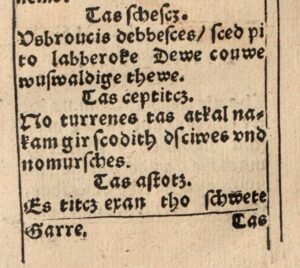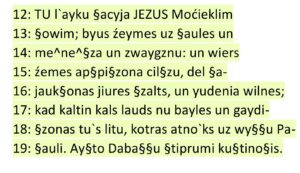5 Kas ītekmej Latgolys i latgalīšu volūdys atškireibys? / What made Latgale and the Latgalian language so distinct?
13. g. s. krysta karu rezultatā senejī latgali, byudami jau pa daļai pareizticeigī, pījam kristticeibu katolicisma formā. Kristticeibā latgali sagloboj ari sovu seņču religiskuos tradicejis. Katuolicisms Latgolā nūsastyprynoj 17.–18. g. s. Pūlejis–Leitovys lelvaļsts laikā. Seviška lūma ir jezuitu i dominikaņu mūku ordeņu darbeibai. 18. g. s. 70. godūs apmāram nu 150 tyukstūšu Latgolys dzeivuotuoju beja ap 100 tyukstūšom katuoļu.
Jezuiti dybynuoja misejis, cēle bazneicys, veiduoja pyrmuos bibliotekys, školys pi bazneicys, kai ari suoce dūmuot par pyrmajim rokstim, lai vītejais dzeivuotuojs saprostu Dīva vuordu i atsasaceitu nu seņču tradiceju. Kai soka, nakryškuoņus raudzeja pīvērst katuoļu ticeibai. Tei ari nūsastyprynuoja tik stypri, ka latgalīši vēļ 20. g. s. suokuos, vaicuoti par tū, kaidys tauteibys jī ir, atsaceja, ka katuoli.
Kai redzim, latgalīšu rokstu volūda jezuitim beja vajadzeiga teiri praktiskam nūdūmam, kab vītejūs latgalīšus pīgrīzt katuoļticeibai.
Nūsaver video i atkuortuoj svareiguokūs viesturiskūs faktus, kas nūsaceja, ka Latgolai ir atškireiga viesture, religiskuo pīdereiba i rokstu volūdys atteisteiba!
1.aizdavums. Savīnoj personeibu ar jam rakstureigū darbeibys vidi ci veikumu!
Kuri ir svareiguokī viesturis fakti, kas ītekmej Latgolys atškirteibu?
Te ir div teksti, vacuokuo saglobuotuo gruomota, kas līk pamatu latvīšu drukuotam vuordam “Katoļu katehisms” (1585), i “Evangelia toto anno” (1753).
 “Katoļu katehisms ”(1585, gotu šrifts)
“Katoļu katehisms ”(1585, gotu šrifts)
 “Evangelia toto anno” (1753, antikvys šrifts)
“Evangelia toto anno” (1753, antikvys šrifts)
Puorskait tūs! Raugi „puorlikt” tekstu atbylstūši myusu dīnu latgalīšu voi latvīšu literarajai volūdai. Kur tys īspiejams, raugi saglobuot religiskam tekstam rakstureigū izteiksmi!
Ka gribi vaira dazynuot par raksteibys atškireibom, nūsaver nūdarbeibu Tavaklase.lv – Rokstu volūdys rasšonuos II!
Taitod viesturiskī nūtykumi i Pūlejis-Leitovys lelvaļsts ītekme nūsoka katuoļu ticeibys nūsastyprynuošonu i atškireigys raksteibys īvīsšonu.
Juopīzeist, ka gotu šritfs puorejūs Latvejis nūvodūs sasagloboj da Latvejis vaļsts izveiduošonys, tik tod puorejā Latvejā puorīt iz latgalīšim īrostū i viesturyskuos atškierteibys laikūs izmontuotū antikvu.
Nu 18. godu symta varim runuot par divejom rokstu tradicejom latvīšu volūdā.
PATURI PRUOTĀ!
| Obeju latvīšu rokstu tradiceju viesturiskuos izaveiduošonys faktori | |
Latgalīšu rokstu pamatā:
|
Vyds dialekta rokstu pamatā:
|
Olūti / Sources
- Catechismvs Catholicorum [..] 1585. http://senie.korpuss.lv/source.jsp?codificator=CC1585
- Evangelia Toto Anno [..] 1753. VILNÆ: Typis S. R. M. Academ. Societ. Jeſu, 1753. http://www.korpuss.lv/senie/static/EvTA1753.html
- Latgolys koncepti. http://futureofmuseums.eu/lg/virtual-gallery/rezekne-higher-education-institution-collections/
- Malahovskis, V. Katuoli. Šuplinska, I. zin. red. Latgolys lingvoteritorialuo vuordineica II. Rēzekne: Rēzeknis Augstškola, 2012, 288.–291. lpp.
- Muizniece, E. Ilgī godi zam svešim jumtim aba deļ kuo tī latgalīši sovaižuoki? Baltie plankumi Latvijas vēsturē. TvNet. https://www.tvnet.lv/6956768/ilgi-godi-zem-svesim-jumtim-aba-del-kuo-ti-latgalisi-sovaizuoki
- Stafecka, A. (atb. red.).Evangelia toto anno 1753. Pirmā latgaliešu grāmata. Rīga: LU Latviešu valodas institūts, 2004.
- Šuplinska, I. Rokstu volūdys rasšonuos, II. Latgalīšu rokstu volūda. Tavaklase.lv – Rokstu volūdys rasšonuos II
In the 13th century, as a result of the crusades to North-Eastern Europe, ancient Latgalians adopted Catholicism, after they had partly converted to Orthodox Christianity earlier. However, in spite of becoming Christians, Latgalians also maintained some of their ancient religious traditions. Catholicism was strengthened in Latgale only in the 17th-18th centuries, when the area belonged to the Polish-Lithuanian Commonwealth. In particular the Jesuits and the Dominicans played an important role in this. In the 1770s, of about 150,000 inhabitants in Latgale, about 100,000 were Catholics.
The Jesuits created missions, built churches, and created first libraries and schools close to their churches. They started to think about the first texts in Latgalian so that the local inhabitants could understand the word of God and abandon their older traditions for good. Generally, they succeeded in establishing the Catholic faith in such an intense way that many Latgalians until the early 20th century, when asked about their national or ethnic identity, replied that they were Catholics.
From this we can see that the Latgalian written language was important for the Jesuits for practical purposes, to convert local Latgalians to Catholicism.
Which important facts and events influenced the differences between Latgale and the rest of Latvia?
In this way, historical events in the Polish-Lithuanian Commonwealth determine the strengthening of the Catholic faith and a way of writing different from Standard Latvian.
It is important to understand that the Gothic fonts are used in the other parts of Latvia until the foundation of the Latvian state, whereas Latgalians maintain antiqua which strengthen the difference to the rest of Latvia.
Therefore, we can talk about two writing traditions in the Latvian language since the 18th century.
KEEP IN MIND!
| Factors which determined the development of both Latvian writing traditions: | |
The Latgalian written language is based on:
|
The Low Latvian written language is based on:
|
 Gothic font
Gothic font
 Antiqua font
Antiqua font
